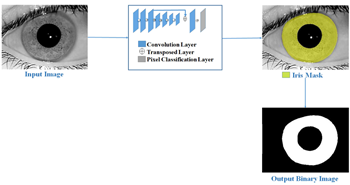Deep Learning-Based Iris Segmentation Algorithm for Effective Iris Recognition System
DOI:
https://doi.org/10.46604/peti.2023.10002Keywords:
CNN, deep learning, iris recognition, iris segmentationAbstract
In this study, a 19-layer convolutional neural network model is developed for accurate iris segmentation and is trained and validated using five publicly available iris image datasets. An integrodifferential operator is used to create labeled images for CASIA v1.0, CASIA v2.0, and PolyU Iris image datasets. The performance of the proposed model is evaluated based on accuracy, sensitivity, selectivity, precision, and F-score. The accuracy obtained for CASIA v1.0, CASIA v2.0, CASIA Iris Interval, IITD, and PolyU Iris are 0.82, 0.97, 0.9923, 0.9942, and 0.98, respectively. The result shows that the proposed model can accurately predict iris and non-iris regions and thus can be an effective tool for iris segmentation.
References
S. Z. Li, Encyclopedia of Biometrics: I-Z (Vol. 2), New York: Springer, 2009.
R. Jillela, et al., “Methods for Iris Segmentation,” Handbook of Iris Recognition, pp. 137-184, October 2013.
“CASIA Version 2.0,” http://biometrics.idealtest.org/downloadDB.do?id=2, May 2021.
M. Mahlouji, et al., “Human Iris Segmentation for Iris Recognition in Unconstrained Environments,” International Journal of Computer Science Issues, vol. 9, no. 1, pp. 149-155, January 2012.
J. Daugman, “How Iris Recognition Works,” The Essential Guide to Image Processing, pp. 715-739, January 2009.
Z. Zhao, et al., “A Deep Learning Based Unified Framework to Detect, Segment and Recognize Irises Using Spatially Corresponding Features,” Pattern Recognition, vol. 93, pp. 546-557, September 2019.
W. Zhang, et al., “A Robust Iris Segmentation Scheme Based on Improved U-Net,” IEEE Access, vol. 7, pp. 85082-85089, June 2019.
Y. Chen, et al., “An Adaptive CNN’s Technology for Robust Iris Segmentation,” IEEE Access, vol. 7, pp. 64517-64532, May 2019.
Y. H. Li, et al., “An Efficient and Robust Iris Segmentation Algorithm Using Deep Learning,” Mobile Information Systems, vol. 2019, Article no. 4568929, January 2019.
S. Bazrafkan, et al., “An End-to-End Deep Neural Network for Iris Segmentation in Unconstrained Scenarios,” Neural Networks, vol. 106, pp. 79-95, October 2018.
S. Lian, et al., “Attention Guided U-Net for Accurate Iris Segmentation,” Journal of Visual Communication and Image Representation, vol. 56, pp. 296-304, October 2018.
H. Hofbauer, et al., “Exploiting Superior CNN-Based Iris Segmentation for Better Recognition Accuracy,” Pattern Recognition Letters, vol. 120, pp. 17-23, April 2019.
M. Sardar, et al., “Iris Segmentation Using Interactive Deep Learning,” IEEE Access, vol. 8, pp. 219322-219330, January 2020.
“IITD Dataset,” https://www4.comp.polyu.edu.hk/~csajaykr/IITD/Database_Iris.htm, July 2020.
K. He, et al., “Deep Residual Learning for Image Recognition,” Proceedings of the IEEE Conference on Computer Vision and Pattern Recognition, pp. 770-778, June 2016.
D. P. Kingma, et al., “Adam: A Method for Stochastic Optimization,” https://arxiv.org/abs/1412.6980, December 2014.
R. Li, et al., “Connection Sensitive Attention U-Net for Accurate Retinal Vessel Segmentation,” https://arxiv.org/abs/1903.05558, March 2019.
“CASIA Iris Dataset Version1,” http://biometrics.idealtest.org/downloadDB.do?id=1, May 2021.
“CASIA Interval Dataset,” http://biometrics.idealtest.org/downloadDB.do?id=4, May 2021.
“PolyU Iris Databases,” https://www4.comp.polyu.edu.hk/~csajaykr/polyuiris.htm, July 2020.
E. Jalilian, et al., “Iris Segmentation Using Fully Convolutional Encoder-Decoder Networks,” Deep Learning for Biometrics, pp. 133-155, August 2017.
M. Arsalan, et al., “IrisDenseNet: Robust Iris Segmentation Using Densely Connected Fully Convolutional Networks in the Images by Visible Light and Near-Infrared Light Camera Sensors,” Sensors, vol. 18, no. 5, Article no. 1501, May 2018.
A. Uhl, et al., “Weighted Adaptive Hough and Ellipsopolar Transforms for Real-Time Iris Segmentation,” 5th IAPR International Conference on Biometrics, pp. 283-290, March 2012.
C. Rathgeb, et al., Iris Biometrics: From Segmentation to Template Security, New York: Springer, 2012.
V. Varkarakis, et al., “Deep Neural Network and Data Augmentation Methodology for Off-Axis Iris Segmentation in Wearable Headsets,” Neural Networks, vol. 121, pp. 101-121, January 2020.
K. Hao, et al., “Iris Segmentation Using Feature Channel Optimization for Noisy Environments,” Cognitive Computation, vol. 12, no. 6, pp. 1205-1216, 2020.

Published
How to Cite
Issue
Section
License
Submission of a manuscript implies: that the work described has not been published before that it is not under consideration for publication elsewhere; that if and when the manuscript is accepted for publication. Authors can retain copyright of their article with no restrictions. Also, author can post the final, peer-reviewed manuscript version (postprint) to any repository or website.

Since Oct. 01, 2015, PETI will publish new articles with Creative Commons Attribution Non-Commercial License, under The Creative Commons Attribution Non-Commercial 4.0 International (CC BY-NC 4.0) License.
The Creative Commons Attribution Non-Commercial (CC-BY-NC) License permits use, distribution and reproduction in any medium, provided the original work is properly cited and is not used for commercial purposes







